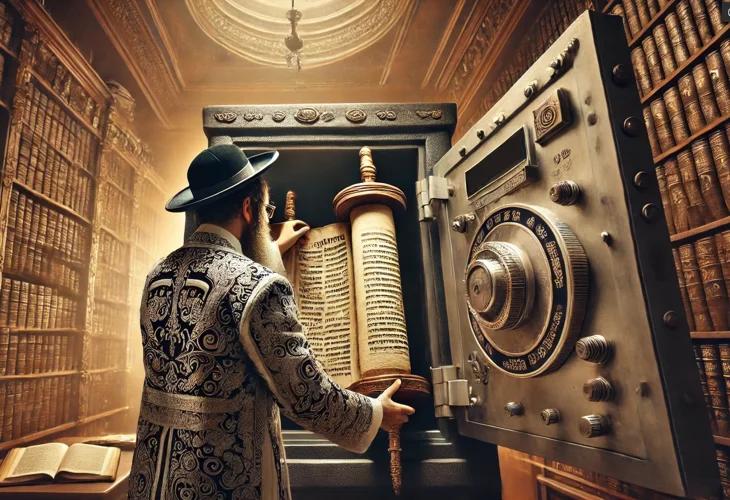Crown of Aleppo: Preserving the Ancient Tradition of Hebrew Punctuation
Did you know the Torah scrolls aren't punctuated? So how did people know how to read them back in the day before printed books?

Did you know the Torah scrolls aren't punctuated? They can't have any marks beyond the letters themselves. Nowadays, we learn punctuation from printed Chumash books, but how did people know the punctuation before such books existed?
Our ancestors passed down the tradition of punctuation orally. Every child who went to school learned from their teacher how to read each verse properly. There's a story in the Talmud about Joab ben Zeruiah's teacher mistakenly teaching him a verse with the wrong punctuation, prompting him to confront his teacher about it years later!
Just like every letter in the Torah holds importance, so does every dot, making it vital to pass on the punctuation tradition accurately. For instance, in Genesis Chapter 36, there are names spelled similarly: Dishon, but they have different punctuations. Seven punctuation forms are found for this name in the chapter: Dishōn, Dishān, Dishōn, Dishān, Dishan, Dishōn, Dishān. Another example is in Joshua (19:29) with the fortress Tzor and later (19:35) with the fortress Tzer.
To remember the correct punctuation, one had to memorize the reading style. In ancient times, there wasn't even a mark for a dot; there was no way to indicate a minus sign under the letter to show a "patach." Everything was oral. The dot forms were established later, and until the era of the Geonim, there were two systems: the Tiberian punctuation and the Babylonian punctuation. The Babylonian system used signs above the letters, but the Tiberian method spread and was adopted.
One reason the Tiberian punctuation spread is the existence of the Ben Asher family. This was a family of grammarians who devoted their lives to examining and refining the text traditions. For six generations, they checked the oldest manuscripts and consulted all the elders and scholars to produce precise versions of the entire Tanach. This family resided in Tiberias during the era of the Geonim. Maimonides managed to obtain one of Ben Asher's copies and based his own Tanach corrections on it. He recorded in his book, "The Strong Hand," the arrangements of the portions and pauses per Ben Asher. The first known grammarian of this remarkable family was Asher, and the Ben Asher who produced the version reached by Maimonides was from the sixth generation. Another family of grammarians, known as "Ben Naphtali," had slightly different versions. For example, Ben Naphtali pronounced "Issachar" as written, while Ben Asher pronounced it "Iscar," without repeating the letter 'Shin'.
Maimonides writes: "The book we relied upon... everyone relied on it - because Ben Asher corrected it and refined it for many years and corrected it numerous times... based on it, I wrote a Torah scroll according to the law..."
The Ben Asher book of Maimonides was passed down with great reverence from generation to generation in Jerusalem's synagogues, with the inscription on its title stating: "This complete volume of twenty-four books... was dedicated by the great minister... from the land of Basra, son of Rabbi Simcha, son of Rabbi Saadia, son of Rabbi Ephraim, may Hashem rest their souls, to Jerusalem, the holy city, for the descendants of Israel, the Jacob community, the Jeshurun congregation... neighbors in Mount Zion... so they can bring it out to the assemblies and communities in the holy city on the Pilgrimage Festivals of Pesach, Shavuot, and Sukkot to read from it and contemplate and learn from it all they wish and choose... throughout the year to see if there is anything added or missing or disordered or arranged or closed or open or any of these accents, they can bring it to them to see and understand, not to read and sermonize, and return it to its place and guard it".
The book was written in ink that couldn't be erased without leaving marks, made from ground tree resin mixed with ferrous sulfate and black soot, making it non-erasable.
Maimonides' descendant, Rabbi David bar Joshua, feared enemies in Jerusalem would harm the precious book, so he moved it to the Aleppo community in Syria in 1375. It was nicknamed "The Crown." The Crown of Aleppo was kept in a locked safe, and no one was allowed to access it. About a century ago, Aleppo's sages permitted a few scholars to approach the book and copy essential information from it.
In 1947, during the lead-up to the establishment of the State of Israel, terrible riots erupted in Aleppo. A frenzied mob looted and burned Jewish homes. The rioters destroyed the Great Synagogue and burned forty Torah scrolls. After the riots, Aleppo's Jews couldn't find the Crown and mourned its loss.
However, the truth is that the synagogue's rabbi, Rabbi Salim Zaafrani, risked his life and entered the burning synagogue, successfully rescuing the Crown and hiding it in a secret place. To prevent Arabs from searching for it, he announced that the Crown had burned.
Rabbis and community leaders wanted to save the Crown from its hiding place, but the situation with Syria was very dangerous, and it was a risky endeavor. Only in 1958 did a brave Jew named Mordechai Faham, exiled from Syria, manage to smuggle the Crown hidden inside an old washing machine. The Crown was delivered to the Israel Museum and is displayed at the "Shrine of the Book" as a perpetual memorial. The Tanach printed by Rabbi Mordechai Breuer was revised and corrected based on the thousand-year-old Crown.

